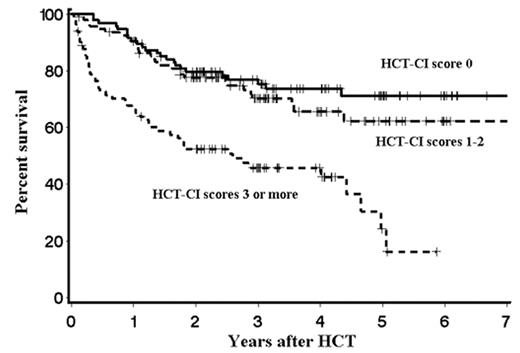Abstract
An HCT-comorbidity index (HCT-CI) was modeled to capture comorbidities and predict outcomes among pts given allogeneic HCT (Blood 2005). Here, we asked whether the HCT-CI could provide prognostic information among pts given autologous HCT. We retrospectively collected and analyzed comorbidities and other pretransplant variables among 273 pts with lymphoma transplanted between 2000 and 2005. Pts were conditioned with cyclophosphamide + total body irradiation or radio-labeled monoclonal antibody (n=127), busulfan/melphalan/thiotepa (n=86), melphalan/cytarabine/BCNU/etoposide (n=37), or other regimens (n=17). Diagnoses were indolent (n=36) or aggressive non-Hodgkin lymphoma (n=169) and Hodgkin lymphoma (n=68). At HCT, 16%, 37%, and 34% of pts had disease transformed from follicular lymphoma, chemosensitive disease, and elevated LDH, respectively. Median age was 49 (range:13–76) years. Median number of prior regimens was 3 and 58% and 26% had prior rituximab and radiotherapy, respectively. HCT-CI comorbidities (score >0, Table 1) were found among 65% of pts, of whom 16% had score 1, 19% score 2, 26% scores 3–4, and 4% scores ≥5. Among pts with scores ≥3 (n=82), 20 had a single comorbidity while 62 had ≥2 comorbidities. In univariate analyses, number of prior regimens, prior rituximab, prior radiotherapy, histology, transformed disease, conditioning regimen, CD34+ cell dose, and time between diagnosis and HCT were not statistically significant in predicting outcomes. Factors which were significant in univariate analyses, were tested in multivariate models (Table 2), where HCT-CI scores independently predicted non-relapse mortality (NRM) and together with LDH and chemosensitive disease predicted overall (OS) and relapse-free survivals (RFS). Pts with HCT-CI scores of 0 vs 1–2 vs ≥3 had 2-year NRM of 3%, 8%, and 19% and OS of 80%, 78%, and 52% respectively (Figure). Further, pts with scores of 3–4 vs ≥5 had NRM and OS of 15% and 57% vs 42% and 25%, respectively. In conclusion, Pts with HCT-CI scores of 0 and 1–2 tolerated high-dose conditioning equally well, while scores ≥3 were associated with increasing mortality. The HCT-CI is an informative tool to assess pts given autologous HCT, and it could provide valuable independent prognostic information when used prospectively.
HCT-CI Comorbidities
| . | . | % . | Score . |
|---|---|---|---|
| Pulmonary | Moderate | 30 | 2 |
| Severe | 9 | 3 | |
| Cardiac | EF ≤ 50% | 7.3 | 1 |
| Arrhythmia | 2.9 | 1 | |
| CAD | 1.8 | 1 | |
| Valvular | 0.7 | 3 | |
| Hepatic | Mild | 6.6 | 1 |
| Moderate | 1 | 3 | |
| Prior malignancy | 5.5 | 3 | |
| Ulcer | 2.6 | 2 | |
| Rheumatologic | 1 | 2 | |
| Renal | 0.4 | 2 | |
| Diabetes | 4.8 | 1 | |
| Psychiatric | 14 | 1 | |
| Infection | 3.7 | 1 | |
| Obesity | 8.8 | 1 | |
| Others | 1.8 | 1 | |
| . | . | % . | Score . |
|---|---|---|---|
| Pulmonary | Moderate | 30 | 2 |
| Severe | 9 | 3 | |
| Cardiac | EF ≤ 50% | 7.3 | 1 |
| Arrhythmia | 2.9 | 1 | |
| CAD | 1.8 | 1 | |
| Valvular | 0.7 | 3 | |
| Hepatic | Mild | 6.6 | 1 |
| Moderate | 1 | 3 | |
| Prior malignancy | 5.5 | 3 | |
| Ulcer | 2.6 | 2 | |
| Rheumatologic | 1 | 2 | |
| Renal | 0.4 | 2 | |
| Diabetes | 4.8 | 1 | |
| Psychiatric | 14 | 1 | |
| Infection | 3.7 | 1 | |
| Obesity | 8.8 | 1 | |
| Others | 1.8 | 1 | |
Multivariate analyses
| . | . | NRM . | Mortality . | RFS . | |||
|---|---|---|---|---|---|---|---|
| . | . | HR . | P . | HR . | P . | HR . | P . |
| *Age was included but was not statistically significabt | |||||||
| HCT-CI scores | 0 | 1 | 1 | 1 | |||
| 1–2 | 1.6 | 0.5 | 1.1 | 0.8 | 1.1 | 0.6 | |
| ≥3 | 6.6 | 0.0009 | 2.9 | <0.0001 | 2.4 | 0.0001 | |
| LDH | Normal | 1 | 1 | 1 | |||
| Abnormal | 1.6 | 0.27 | 2.0 | 0.001 | 1.6 | 0.01 | |
| Chemosensitivity | Yes | 1 | 1 | 1 | |||
| No | 1.2 | 0.7 | 1.6 | 0.02 | 1.7 | 0.005 | |
| . | . | NRM . | Mortality . | RFS . | |||
|---|---|---|---|---|---|---|---|
| . | . | HR . | P . | HR . | P . | HR . | P . |
| *Age was included but was not statistically significabt | |||||||
| HCT-CI scores | 0 | 1 | 1 | 1 | |||
| 1–2 | 1.6 | 0.5 | 1.1 | 0.8 | 1.1 | 0.6 | |
| ≥3 | 6.6 | 0.0009 | 2.9 | <0.0001 | 2.4 | 0.0001 | |
| LDH | Normal | 1 | 1 | 1 | |||
| Abnormal | 1.6 | 0.27 | 2.0 | 0.001 | 1.6 | 0.01 | |
| Chemosensitivity | Yes | 1 | 1 | 1 | |||
| No | 1.2 | 0.7 | 1.6 | 0.02 | 1.7 | 0.005 | |
Figure
Author notes
Disclosure:Off Label Use: Off-label discussions will include the use of Total body irradiation, cyclophosphamide, busulfan, thiotepa, melphalan, cytarabine, BCNU, and etoposide for conditioning before autologous hematopoietic cell transplantation.


This feature is available to Subscribers Only
Sign In or Create an Account Close Modal